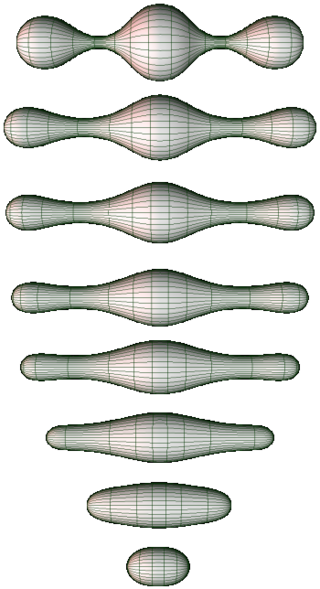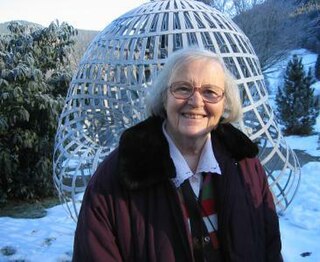
In the mathematical fields of differential geometry and geometric analysis, the Ricci flow, sometimes also referred to as Hamilton's Ricci flow, is a certain partial differential equation for a Riemannian metric. It is often said to be analogous to the diffusion of heat and the heat equation, due to formal similarities in the mathematical structure of the equation. However, it is nonlinear and exhibits many phenomena not present in the study of the heat equation.

The Penrose–Hawking singularity theorems are a set of results in general relativity that attempt to answer the question of when gravitation produces singularities. The Penrose singularity theorem is a theorem in semi-Riemannian geometry and its general relativistic interpretation predicts a gravitational singularity in black hole formation. The Hawking singularity theorem is based on the Penrose theorem and it is interpreted as a gravitational singularity in the Big Bang situation. Penrose was awarded the Nobel Prize in Physics in 2020 "for the discovery that black hole formation is a robust prediction of the general theory of relativity", which he shared with Reinhard Genzel and Andrea Ghez.

Shing-Tung Yau is a Chinese-American mathematician and the William Caspar Graustein Professor of Mathematics at Harvard University. In April 2022, Yau announced retirement from Harvard to become Chair Professor of mathematics at Tsinghua University.

In the general theory of relativity, the Einstein field equations relate the geometry of spacetime to the distribution of matter within it.
In theoretical physics, the Einstein–Cartan theory, also known as the Einstein–Cartan–Sciama–Kibble theory, is a classical theory of gravitation similar to general relativity. The theory was first proposed by Élie Cartan in 1922. Einstein–Cartan theory is the simplest Poincaré gauge theory.
In the mathematical field of differential geometry, Ricci-flatness is a condition on the curvature of a (pseudo-)Riemannian manifold. Ricci-flat manifolds are a special kind of Einstein manifold. In theoretical physics, Ricci-flat Lorentzian manifolds are of fundamental interest, as they are the solutions of Einstein's field equations in vacuum with vanishing cosmological constant.
In differential geometry and mathematical physics, an Einstein manifold is a Riemannian or pseudo-Riemannian differentiable manifold whose Ricci tensor is proportional to the metric. They are named after Albert Einstein because this condition is equivalent to saying that the metric is a solution of the vacuum Einstein field equations, although both the dimension and the signature of the metric can be arbitrary, thus not being restricted to Lorentzian manifolds. Einstein manifolds in four Euclidean dimensions are studied as gravitational instantons.

Richard Streit Hamilton is an American mathematician who serves as the Davies Professor of Mathematics at Columbia University. He is known for contributions to geometric analysis and partial differential equations. Hamilton is best known for foundational contributions to the theory of the Ricci flow and the development of a corresponding program of techniques and ideas for resolving the Poincaré conjecture and geometrization conjecture in the field of geometric topology. Grigori Perelman built upon Hamilton's results to prove the conjectures, and was awarded a Millennium Prize for his work. However, Perelman declined the award, regarding Hamilton's contribution as being equal to his own.
In general relativity, Regge calculus is a formalism for producing simplicial approximations of spacetimes that are solutions to the Einstein field equation. The calculus was introduced by the Italian theoretician Tullio Regge in 1961.
The Cartan–Karlhede algorithm is a procedure for completely classifying and comparing Riemannian manifolds. Given two Riemannian manifolds of the same dimension, it is not always obvious whether they are locally isometric. Élie Cartan, using his exterior calculus with his method of moving frames, showed that it is always possible to compare the manifolds. Carl Brans developed the method further, and the first practical implementation was presented by Anders Karlhede in 1980.

The mathematics of general relativity is complex. In Newton's theories of motion, an object's length and the rate at which time passes remain constant while the object accelerates, meaning that many problems in Newtonian mechanics may be solved by algebra alone. In relativity, however, an object's length and the rate at which time passes both change appreciably as the object's speed approaches the speed of light, meaning that more variables and more complicated mathematics are required to calculate the object's motion. As a result, relativity requires the use of concepts such as vectors, tensors, pseudotensors and curvilinear coordinates.
In differential geometry, a Kähler–Einstein metric on a complex manifold is a Riemannian metric that is both a Kähler metric and an Einstein metric. A manifold is said to be Kähler–Einstein if it admits a Kähler–Einstein metric. The most important special case of these are the Calabi–Yau manifolds, which are Kähler and Ricci-flat.
The initial value formulation of general relativity is a reformulation of Albert Einstein's theory of general relativity that describes a universe evolving over time.
Robert Bartnik is an Australian mathematician based at Monash University. He is known for his contributions to the rigorous mathematical study of general relativity. He received his bachelor's and master's degrees from Melbourne University and a PhD in mathematics from Princeton University in 1983, where his advisor was Shing-Tung Yau. In 2004 he was elected to the Australian Academy of Science, with citation:
Professor Bartnik is renowned internationally for the application of geometric analysis to mathematical problems arising in Einstein's theory of general relativity. His work is characterised by his ability to uncover new and anticipated phenomena in space-time geometry, often employing sophisticated tools from linear and nonlinear partial differential equations as well as elaborate numerical computations. He has contributed greatly to our understanding of the properties of the Einstein equations and gravitation.
The Geometry Festival is an annual mathematics conference held in the United States.

Yvonne Choquet-Bruhat is a French mathematician and physicist. She has made seminal contributions to the study of Einstein's general theory of relativity, by showing that the Einstein equations can be put into the form of an initial value problem which is well-posed. In 2015, her breakthrough paper was listed by the journal Classical and Quantum Gravity as one of thirteen 'milestone' results in the study of general relativity, across the hundred years in which it had been studied.
In mathematical physics, Kundt spacetimes are Lorentzian manifolds admitting a geodesic null congruence with vanishing optical scalars. A well known member of Kundt class is pp-wave. Ricci-flat Kundt spacetimes in arbitrary dimension are algebraically special. In four dimensions Ricci-flat Kundt metrics of Petrov type III and N are completely known. All VSI spacetimes belong to a subset of the Kundt spacetimes.

In theoretical physics, shape dynamics is a theory of gravity that implements Mach's principle, developed with the specific goal to obviate the problem of time and thereby open a new path toward the resolution of incompatibilities between general relativity and quantum mechanics.

Gerhard Huisken is a German mathematician whose research concerns differential geometry and partial differential equations. He is known for foundational contributions to the theory of the mean curvature flow, including Huisken's monotonicity formula, which is named after him. With Tom Ilmanen, he proved a version of the Riemannian Penrose inequality, which is a special case of the more general Penrose conjecture in general relativity.







